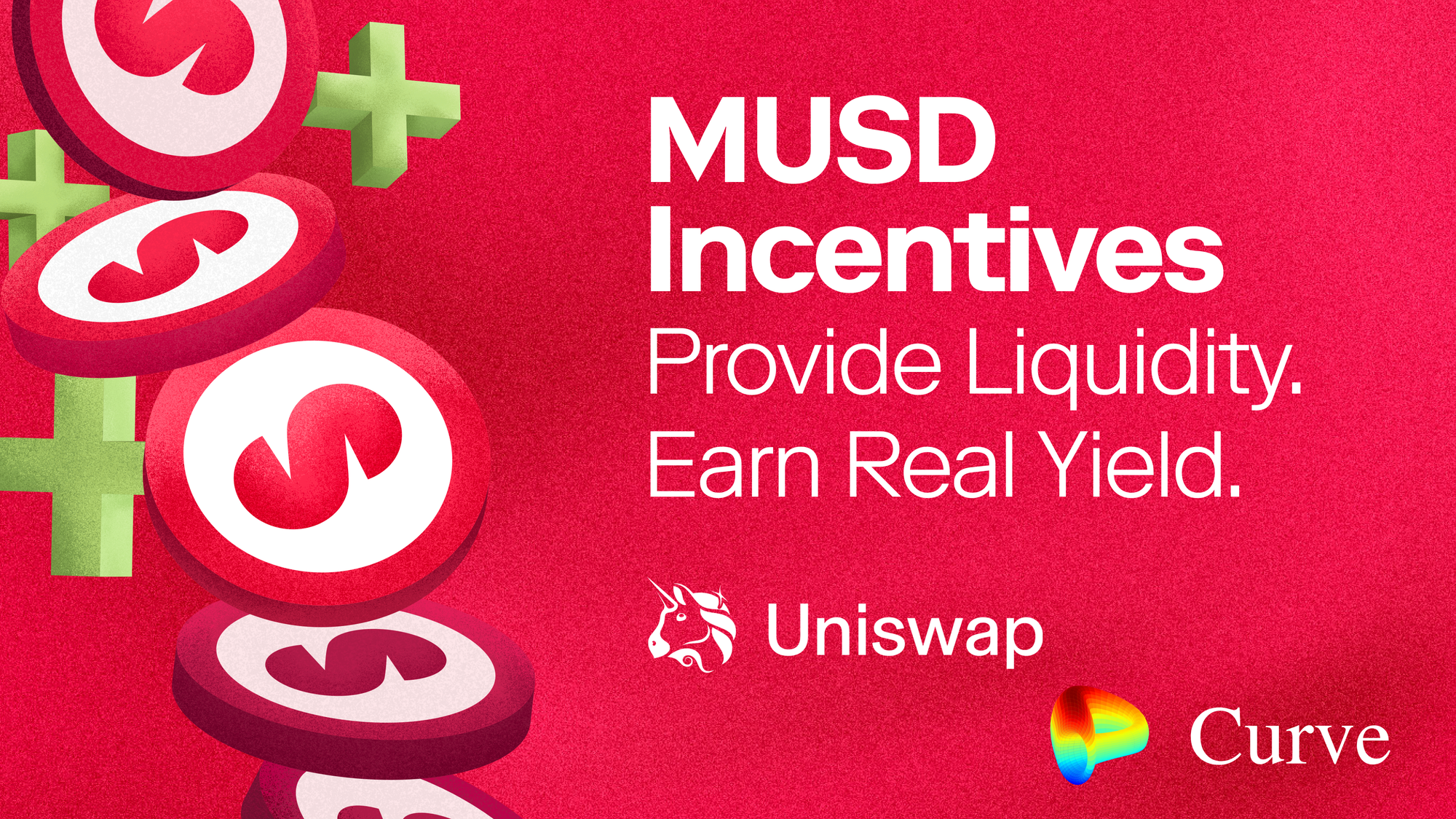Save Your Bitcoin, Earn With MUSD: Boosted Liquidity Incentives Live on Curve and Uniswap
Stay long BTC while your MUSD earns yield for you. This week, bonus incentives are launching for Curve and Uniswap pools. Borrow against your Bitcoin at a fixed 1% rate, and bridge your MUSD into Ethereum for the juiciest yield opportunities to date.

The best trades are often the simplest. With new liquidity incentives going live, the math on Mezo's Bitcoin loans becomes painfully simple: Borrow at 1% APR while you earn more yield with your MUSD.
Starting this week, bonus MUSD liquidity incentives are live on both Uniswap and Curve pools. Early movers can earn the highest weekly rewards while building deep liquidity for onchain Bitcoin banking.
This means that with Mezo, Bitcoin holders can:
- Borrow at a fixed 1% rate
- Bridge MUSD via Wormhole
- Provide liquidity on Curve and Uniswap
- Earn boosted rewards (that can pay back your loan!)
All while retaining complete autonomy: close your position whenever you want, repay as you see fit, add more collateral... It's your Bitcoin, so you decide what to do.
Mezo's self-service banking model now allows you to earn additional yield while maintaining your BTC position.
Where To Get The Incentives
Various pools are available for farming, depending on your preferred strategy and typical asset holdings.
Uniswap v4:
Curve:
While the pools are planned to be incentivized for the next 8+ weeks, the actual incentives reset weekly. So, be sure to check roughly every week to see if the estimated yield for the pools has changed.
Why Should You Deposit Now?
The incentives aren't going to last forever. Early deposits will get the highest yields because TVL will be at its lowest point. This is classic DeFi economics - those who provide liquidity when it's needed most earn the greatest rewards.
Grab your share now. Rewards will be claimable weekly, giving you consistent returns on your MUSD while your underlying Bitcoin position remains untouched. While providing liquidity on a platform like Uniswap v4 involves a few important steps, the boosted yields for early movers make it well worth the effort. Our guide below will walk you through it.
How to Participate: A Step-by-Step Guide
Before Getting Started: Check the Merkl campaign
- Open the Merkl campaign page for your target pool.
- Read “Eligibility / Tick limits” (some require a max width or a target corridor).
- Note the chain, fee tier, pool address, reward tokens, and distribution cadence.
- Only then open Uniswap/Curve to add liquidity so your range matches the campaign.

Your path to earning yield will have slightly different starting steps depending on whether you are getting MUSD on Mezo or buying it directly on Ethereum. Follow the path that’s right for you.
Path A: Starting on Mezo (borrowing MUSD)
Follow these steps if you have BTC on Mezo and want to borrow MUSD against it.
Get MUSD:
- Borrow: If you have BTC, open an MUSD loan on Mezo.
- Swap & Borrow: Use Mezo to swap other assets to BTC, then take out an MUSD loan.
Bridge to Ethereum:
- Since your MUSD was created on Mezo, you'll need to move it. Use the integrated Wormhole bridge to transfer your MUSD to the Ethereum network with a single click.
Continue to the Provide Liquidity step next.
Path B: Starting on Ethereum (by Buying)
Follow this step if you prefer to buy MUSD on a secondary market.
Get MUSD:
- Buy MUSD directly on an Ethereum-based market like Curve or Uniswap.
You're Ready!
- Because you bought MUSD directly on Ethereum, no bridging is required. Your MUSD is already where it needs to be.
Continue to the Provide Liquidity step below.
Provide Liquidity & Set Your Range
Once your MUSD is on the Ethereum network (either by bridging or buying), follow these crucial final steps.
- Visit the Rewards Dashboard: First, head to the Merkl dashboard for Mezo. Here, you can see all the eligible pools and their current reward APRs.
- Choose Your Pool: Select the pool you want to join (e.g., MUSD/USDC on Uniswap). Clicking it on Merkl will take you to the correct Uniswap or Curve page.
- Deposit on Uniswap (Important!):
- When you add liquidity to a Uniswap v4 pool, you must set a price range for your position. Your liquidity will only earn fees and rewards while the market price of the assets stays within your selected range.
- This is not the default setting. You must actively choose your upper and lower price bounds. If the price moves outside your range, you will stop earning rewards until it moves back in or you create a new position.
- For example, in an MUSD/USDC pool, you might set a tight range from $0.995 to $1.005 to maximize your earnings while the peg is stable. A wider range may be safer for more volatile pairs like tBTC/MUSD.
PRO TIP: The settings on Uniswap can be complex for new users. Take time to understand how concentrated liquidity works. A tighter range can earn more fees but carries a higher risk of going out of range. A wider range is safer but may earn less. Check out Uniswap docs for more info.
Earn!
Once your MUSD is deposited into the liquidity pool on Uniswap or Curve, you're all set! There is no need to stake your LP token anywhere else. Your position is automatically eligible for rewards.
You can return to the Merkl dashboard at any time to see your accrued rewards, which are available to claim weekly. Use them to pay back your loan or compound your earnings!
Merkl has a unique reward distribution system. Below are a few important highlights. For full info, check out the Merkl docs.
- Merkl distributes the bonus rewards; you don’t stake anywhere. You LP on Uniswap or Curve as usual; Merkl tracks your LP position on‑chain and accrues rewards. You later claim them on the Merkl app (“Dashboard → My rewards”). No extra vault or staking step is required.
- Claims are not instant; they unlock in batches. Merkl pushes new “merkle roots” on a fixed cadence (chain‑dependent, ~4–12 hours on average). Your balance updates after the next root, then you can claim.
- Range matters on Uniswap (v3/v4). Most Merkl campaigns only reward in‑range liquidity, and some set tick‑price limits (eligibility corridors); full‑range or default ranges often don’t qualify. Always read the campaign’s “Eligibility / Tick limits” before you add liquidity.
The New Bitcoin Banking Model
Imagine a scenario where you need cash, but your Bitcoin is pumping. The old way forces an impossible choice: sell your BTC at whatever price the market offers, or crawl to a bank for a 10% APR loan. Either way, you lose. You're either watching Bitcoin rally from the sidelines or paying banks to access your own wealth.
Mezo's self-service banking flips this entire model. Borrow at 1% fixed against your BTC (the lowest rates in DeFi!) whenever you want. Then, deploy that MUSD into liquidity pools, earning multiples of your borrowing cost.
Your loan basically pays itself through yield while your underlying Bitcoin continues to appreciate. You're taking BTC from a HODL-first mentality and turning it into productive capital without sacrificing your position.
Simply, you're having your cake and eating it, too.
The Bottom Line
- Your Bitcoin stays locked as collateral, appreciating over time
- Your MUSD earns yield across DeFi's most liquid venues
- Your loan pays itself through liquidity provision returns
Weekly rewards start this week. The earlier you move, the greater your share.
Time to make your Bitcoin work without letting it go.
Follow @MezoNetwork
🏦 Start borrowing • 📚 Read the docs • 💬 Join Discord • 🛡 View audits
*References to expected yields, APY, or other performance metrics are based on current performance and protocol parameters. Actual returns may be subject to change due to market conditions, protocol governance decisions, and other risk factors. Users are responsible for carrying out their own due diligence before choosing a Vault, and for monitoring any changes made to the Vault over time, particularly those subject to a time lock.
